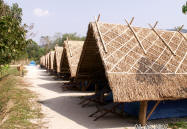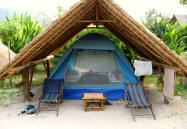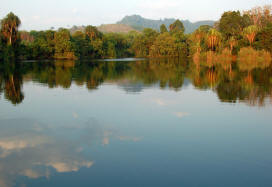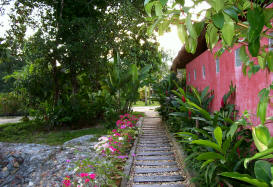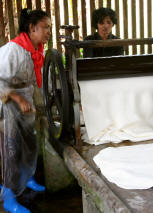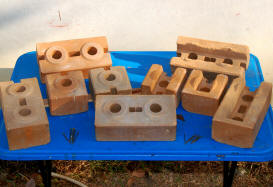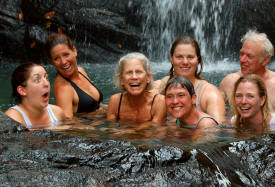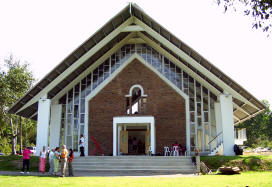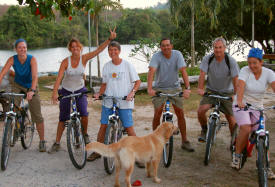Working and Living in the Phang Nga District
A brief overview for Habitat teams assigned to the Na Fay affiliate
By Susi Havens-Bezaire
(Click photos to see full size)
Our Habitat team flew into Phuket and we were met at the airport by Eim, GV Coordinator for the HRC-South district. We had a designated meeting spot in front of a restaurant on the 1st floor that was easy for team members to locate. The airport is small and easy to get around and a great place to exchange your dollars for baht.
The Lagoon
Two vans drove us 45 minutes north to Sawasdee Lagoon. Our team loved staying at the lagoon! The grounds are filled with beautiful flowers and the lagoon is lined with many types of trees. One area has a grove of rubber trees, which is quite common in the area.
There is a row of tents, each with 2 cots and a table, that run along the lagoons’ edge. The tents are supplied with electricity (220 volts) via an extension cord into which the overhead light & fan connect. (However, most members found that it cooled down enough at night to turn the fan off for sleeping.) This made it easy to re-charge our camera or laptop batteries. There is also another row of tents across the soccer field, but I believe they do not have electricity and cost less. The staff cleaned our tents and supplied clean linen & towels about every 3 days. (We call it luxury camping!)
It is very quiet and peaceful at the lagoon, if somewhat remote. The staff - most are family members - was very welcoming and worked very hard to accommodate our team. After we finished with work every afternoon, about half the team would go swimming or kayaking. The deep lagoon is fed by fresh water flowing from the rain forest mountains in the distance – which meant that the water was not stagnant. We were there during the dry season and did not have any rain, but the water still ran consistently through the lagoon spillway. Some team members enjoyed getting a Thai massage at the end of a hard day of work.
The staff prepared wonderful meals for us (breakfast & dinner). They were also able to accommodate some team members request for non-spicy food. There was always a lot of fresh fruit (including many types we had never seen but found to be wonderful) vegetables, soups, and multiple main dishes. We ate together under a pavilion with a thatched roof. They obviously prepare the food safely, as we had zero cases of illness during our three-week stay. We did occasionally have to grab for the water after finding a hidden "hot bomb"... some of the chiles were very hot! We even had a Thai cooking lesson one afternoon, and reciprocated two nights later by teaching the staff how to made a barbeque chicken dinner, complete with coleslaw and garlic mashed potatoes.
The bathrooms are very contemporary and cleaned daily. Except for the occasional toad or gecko who would visit, they were great. There are 3 toilets & 3 showers, 4 sinks in the women's - I never ventured in the men's but assume it was similar. (Editor's note: The men's room had only 2 sinks.) It is a bit of a walk from the tents, but the grounds are well lighted at night. The pathway to the ladies room is filled with roses and other flowers. Most nights the only sound that interrupted the chirping critters or barking dog was the zipppp of a tent zipper, then the flip flop shuffle as someone headed off for a midnight trek to the toilet.
There was also a smaller pavilion, near the tents, that team members used to read, write or have conversation once it got dark or tent mates went to bed. Keep in mind - we had worked so hard that even Dave, who usually requires only 3 – 4 hours of sleep, never stayed awake past 9:30 or 10:00 p.m!
Security
Dave and I always bring a hard sided suitcase with a bicycle cable and lock. We ask our team members to bring a small bag or zip lock marked with their name to stash all their important documents, extra money, flight tickets and passports in. We locked our laptop and the documents in the suitcase and used the cable and lock to attached it to the shelves in the Lagoon's main office. Both Dave & I have a key and the office was accessible to us anytime we needed. We also asked our team members to make a color copy of their passport to keep with them instead of carrying their passports.
The Lagoon seemed very safe. There are 3 friendly family dogs who police the area all the time and let the family know when someone or a some critter come onto the grounds. The Lagoon had other customers on the weekends, but we were the only guests during the weekdays.
The Work Site
Our transportation to the work site was in 2 trucks with seats along both sides of the back. It is a common form of transportation in Thailand. Our drivers were very safe, defensive drivers, as are most drivers in Thailand (except Bangkok). It would take us about 10 -15 minutes to get to the sites.
Na Fay is a 500 person farming community, and the Na Fay Habitat affiliate plans to complete 10 houses in the current build cycle. The families primarily work producing rubber from the local trees. We even got to see the process by which they prepare the raw latex for pickup in a small building behind the brick “factory”. Their farming occupied most of their time in the mornings, and then most of the families worked either in the brick factory or on the houses in the afternoons. Six paid craftsmen work full time on the houses and four laborers work in the factory. You will enjoy working with all of them! We were the first of 8 Habitat teams that Eim will be coordinating in the next few months.
The type of construction used by this affiliate is a result of the critical need for materials following the tsunami. A “factory” was developed, in collaboration with World Concern, for the Habitat families to make compressed bricks that are interlocking – similar to legos. Although it was hard work to produce the blocks at a steady pace through the day, there were some team members that really enjoyed the physical labor. Inexperienced volunteers also found the interlocking blocks easy to work with and quickly learned how to lay “well made” walls. It is unclear whether the affiliate will continue to use the blocks or use more traditional materials in their future homes.
We also were very fortunate to work with Kelly, a firefighter from Montana, and Brian, a builder from Canada. They were traveling (individually) in Thailand and decided to volunteer with Habitat and were both assigned to work at the Na Fay affiliate. Brian had also helped in the tsunami relief the past year. It was nice getting to know them both and we hope our paths will cross again. The first week a high school group from Korea also joined us, which added another dimension to sharing cultures.
Downtime and R&R
On the way back to the Lagoon after a hard day, your team may enjoy taking a cool dip in the waterfall near the construction site, or stopping at a beautiful, deserted ocean beach. It was also the site of a wat where we met a very friendly English-speaking monk who happily gave us a 10-minute crash course in the fundamentals of Buddism. We enjoyed seeing the local market that is set up each Wednesday on a street near the Lagoon, and which pleased the shoppers in the group. The Lagoon had one computer with slow internet access, so about every other day we had our truck take us to town 20 minutes away to visit the Internet cafe. A word of caution - frequently the Internet connections were slow or even down... An interesting form of commerce was the traveling salesmen/women who would drive by the construction sites on their motorbikes or trucks, honking their horns to announce their arrival. Clothing, pancakes, ice cream, meat, eyeglasses, vegetables & fruits, etc. could be purchased from them.
We went into the somewhat larger city of Khao Lak (40 minutes) for church on Sunday. We also visited a Tsunami memorial in a nearby fishing village that had lost half of its 3000 person population that one terrible day. Fortunately, it has been rebuilt already. Another highlight was a Sunday snorkeling and scuba diving in the Andaman Sea! One interesting fact is that the number of Christian churches in the area has increased 1 to 11 as a result of all the volunteers who have come to help in the tsunami relief effort.
A fun activity was soccer at 5:30 each evening at the Lagoon field with most of the paid craftsmen, some of the families, and many of our team members. It was a great way to break down barriers, though a few of us did limp off the field.
The Lagoon had several bicycles available to ride, and 6 members even rode through the rubber trees one day to the construction site – which was convenient because it was the day one of the trucks broke down! Many members would walk/run on the single lane road in the early evenings. We found the Thai people always friendly, polite and welcoming – everyone waved to us as we would go by their homes.
Definitely, don't miss an R & R day arranged by Eim to Phang Nga bay - everyone loved it!

 Who
Who